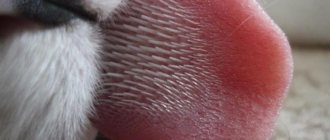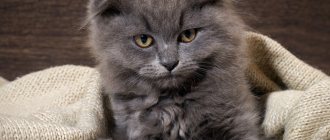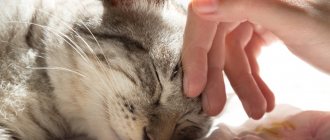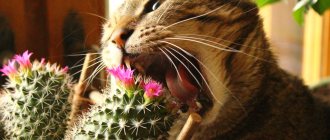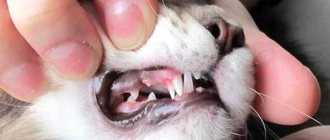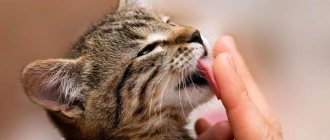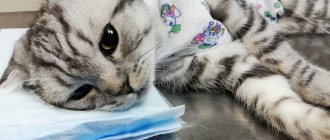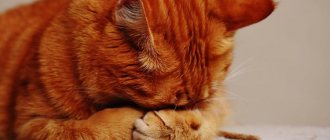6874Pavel
3
A phenomenon that is perceived from people with hostility, misunderstanding, and sometimes with concern for their health, is perceived with affection from cute pets. When a cat farts, we even want to laugh. But why does a cat fart? Perhaps there is no reason to laugh, but is this a warning to us, the owners, that the animal is not in good health? Or is the problem not so serious that you need to worry about it? Let's look at the reasons why a cat farts. And we will understand how to act and what the cat needs.
Do cats fart?
Increased gas formation occurs as a result of fermentation of food residues in the body. The deviation is caused by the formation of large gas bubbles, difficulties with moving the food bolus, intestinal colic, and an unpleasant odor when cleaning the intestines. Cats fart because the food they eat goes through a complete processing process in the gastrointestinal tract.
Confused cat who got rid of accumulated gases
How to tell if a cat is farting
With flatulence, the animal experiences rumbling sounds in the abdomen; palpation examination shows an increase in the intestinal volume, moderate pain when touched. The pet can sleep peacefully, but when the accumulated gases escape, it suddenly wakes up, jumps on its paws, and meows.
The pathology provokes the development of diarrhea and constant anxiety in the furry pet. If a cat farts, then the problem is related to the inability to fully process the food it eats. Flatulence indicates an incorrect diet or the formation of gastrointestinal diseases.
Good and bad food
The anatomical structure does not provide for increased gas formation due to the short digestive tract. This feature helps the body quickly absorb nutrients and remove metabolic products. Improper care of your pet leads to cats periodically farting.
For your information! According to statistics, young and older animals are susceptible to similar anomalies. Middle-aged cats suffer from flatulence due to the fault of their owners.
Flatulence in cats
Active formation of gases may be associated with air entering the stomach during rapid absorption of food, or with diseases of the digestive tract. The accumulation of fermentation products causes flatulence and belching, causing even a small kitten to fart.
Deformation of the intestinal walls under the influence of gases provokes attacks of vomiting, diarrhea, and cramps. The manifestations are dangerous for pets, but the situation worsens with repeated meals. Stopping the normal processes of processing the food bolus leads to its accumulation in the gastrointestinal tract and rotting. A large amount of unprocessed residues causes general intoxication of the body and a putrid odor.
Treatment of flatulence
Owners sometimes don’t even know if a cat is farting, because unlike humans, animals do it very quietly. Flatulence in cats becomes obvious with the appearance of a foul odor.
The first measure is to change the diet, even if the cat eats only special food. You will have to experiment to find out what causes the accumulation of gases in the animal. To prevent your cat from swallowing excess air, it is recommended to soak ready-made dry food first.
If an unpleasant odor appears during the release of gases, the animal should be shown to a veterinarian. If the doctor diagnoses “dysbacteriosis”, then probiotics will be needed, most often Lactoferon. Together with them, you will need to help the body get rid of toxins by giving activated charcoal or Atoxil. Smecta will help eliminate irritation of the intestinal walls, and Espumisan will help reduce gas formation. Kittens can be fed with dill water.
Food allergies and intolerances to certain foods are treated with antihistamines. In severe cases, the cat will be prescribed antibiotics. If gas formation is associated with pathology of internal organs (with intestinal obstruction), surgery is performed.
Main causes of gas
Why do cats sleep a lot: the main reasons and is it normal?
Cats fart for a reason; the problem is caused by improper feeding, accumulation of hair in the gastrointestinal tract, helminths and other sources. When a pathology appears, the owner needs to check why the cat is experiencing flatulence.
Dangerous foods for pets
Poor nutrition
Most often, a cat repeatedly spoils the air due to an incorrectly selected diet containing large amounts of carbohydrates. Food enriched with them lingers in the intestinal tract and begins to rot, causing poisoning. Feeding from a common table leads to the fact that animals begin to fart constantly.
Important! Many careless owners sincerely believe that spoiled food does not harm the cat’s body. Rotten feed irritates the mucous membranes of the gastrointestinal tract, causing intoxication, vomiting, diarrhea and flatulence.
Cats love milk, but the effects on their stomach after drinking it are not very pleasant.
Veterinarians have compiled a list of reasons why cats fart.
- Bakery products. Feeding pieces of a bun or cake leads to fermentation processes in the intestinal tract. Yeast and carbohydrates are harmful to pets; constant feeding with sweet buns over time provokes inflammatory processes in the gastrointestinal tract.
- Milk products. The usefulness of milk, sour cream and kefir for adult animals is questionable. The body of a mature individual does not produce special enzymes that help digest these products. Active feeding with dairy and fermented milk products becomes a source of lactose intolerance. One saucer of milk sometimes leads to prolonged, two-month therapy for the affected animal.
- Fish products. The second common misconception is the recommendation to constantly feed fish. The carnivorous nature of cats requires meat, and fish products are allowed on the menu no more than once a week. An excess can lead to the formation of kidney stones, especially in males, digestive disorders, and increased gas formation.
- Spices. Spices, garlic and onions are among the enemies of the gastrointestinal tract of furry pets. They cause gastritis, colitis and other inflammatory phenomena of the gastrointestinal mucosa. The misconception about the benefits of spicy vegetables in the fight against worms and colds comes from rural areas, where these pathologies predominate among the population.
- Fat and meat trimmings. Attempts to feed the animal with cartilage, fat and fascia are successful. The predominance of these “delicacies” causes indigestion, problems with liver function, flatulence, and diarrhea. Constant feeding of junk food will result in chronic diseases of the digestive system.
- Cereals. The omnivorous nature of cats is one of the common myths. The unfortunate hungry animal is forced to eat the soy, wheat and corn products offered. They are a source of increased gas formation and disturbances in the gastrointestinal tract.
Do domestic cats fart on expired food? Spoiled food and meat with a characteristic odor initially cause flatulence. The consequences of such a diet include intoxication, serious diseases, and helminths.
Balls of wool
Ignoring the need for constant care for pets, especially long-haired breeds, leads to the accumulation of hairballs in the intestinal tract. They interfere with the digestive processes, leading to stagnation of the food bolus, its rotting and fermentation. Not all individuals have a well-developed gag reflex, which allows them to regurgitate trichobezoars - dense balls of compressed hair that stretch the intestines, causing diarrhea, vomiting, and flatulence.
Vomiting in a cat is a sign of many ailments
Intestinal parasites
If your cat farts repeatedly, the problem may be intestinal parasites. Worms are localized in the small intestine and cause irritation of its mucous membranes and allergic reactions. A large accumulation of helminths leads to blockage of the lumen of the gastrointestinal tract and bile ducts. With parasites, a cat experiences not only increased gas formation, but also constipation.
But there are other sources of flatulence.
- Allergic reactions. Individual intolerance to certain foods causes allergy outbreaks. Pathology is associated with a variety of products, but more often it occurs due to milk sugars, gluten, and artificial components in finished feeds. Cheap varieties contain ingredients that make the animal want to eat them constantly. As a result, it suffers from gas, colic, and pain in the gastrointestinal tract.
- Viruses. Infection occurs through constant visiting of the street. Domestic animals are less likely to become ill with parvovirus compared to free-roaming animals. Average statistical data indicate that every second cat suffers from it due to contact with the outside world.
- Inflammation. The development of pathology is determined by diarrhea, bouts of vomiting, and bad breath. Severe gas formation during the inflammatory process is a secondary symptom. A sick pet requires a visit to the veterinarian and antibiotic treatment.
- Dysbacteriosis. Disturbance of the balance of normal microflora is associated with antibiotic therapy, poor nutrition and subsequent intoxication. The disease provokes disruption of the immune system and flatulence. Do small kittens fart when they have dysbacteriosis? In young animals, the disease is caused by transferring to roughage after mother's milk, from wet to dry food.
- Constipation. A prolonged delay in defecation provokes increased gas formation. An overfilled gastrointestinal tract irritates the pet, and constant discomfort leads to loin riding on the floor and meowing plaintively.
- Impaired functionality of the intestinal system. Pathological inability to process food normally is more common in cats with congenital abnormalities. Other causes of dysfunction include injuries and previous gastrointestinal diseases. Only a veterinarian can determine the source of the disorder after a full diagnostic examination.
- Air entering the stomach. Eager consumption of food leads to belching and gas formation. Increasing the frequency of feeding and reducing the size of portions quickly solves the problem.
Important! If the pet spoils the air regularly, the owner should consult a veterinarian.
In some pathologies, ignoring the symptoms can cost him not only his health, but also his life.
Features of the stomach
A cat's stomach is single-chamber. The inside is lined with a mucous membrane that produces gastric juice. There are two openings from the stomach: one opens into the esophagus, and the other opens into the small intestine.
The cat's stomach serves to store food and control the rate at which food enters the intestines and secretes enzymes necessary for the digestion process. Mixing and grinding of food occurs in it. With muscle movements, it directs food into the small intestine.
When food enters the stomach, its bottom relaxes to reduce intragastric pressure. The smell and taste of food causes the secretion of gastric juice. Digested food is sent to the intestines, and its undigested part remains in the stomach. The more caloric a food is, the slower it is digested.
We invite you to read: Pigeons of Kuban full description of species
Changing your diet
Why cats love valerian: the main reasons for their sympathy
Improper feeding is one of the main sources of indigestion and gas in a cat. A lack or excess amount of food, an incorrectly selected diet, and eating waste from the master’s table provoke gastrointestinal dysfunction. Mature pets are in a subgroup at increased risk for the disease, and their weakened bodies require a sufficient supply of vitamins and minerals.
Note! Good expensive food has a high price, but does not harm animals. They are categorized by age, activity level and body weight. They cannot overfeed or underfeed your furry pet.
Why are cheap options not suitable? They have added foreign components - legumes, soybeans, corn. For a carnivorous predator, they are foreign and are poorly digested in the gastrointestinal tract. Artificial flavor enhancers and other flavorings become a favorable source of proliferation of pathogenic microflora.
You cannot buy food according to your pet’s taste preferences. If earlier he avoided foods that were dangerous to health, now manufacturers manage to lull his vigilance with third-party additives. Inexpensive food is made from components that attract attention and interest the animal. The result of saving is a storm in the stomach due to active fermentation.
Manufacturers of branded mixtures indicate on the packaging the constituent ingredients: proteins, a mixture of poultry, beef, rabbit and other animals, vegetable fats. They do not contain soy, corn and other components that increase the weight of the feed.
Does my cat pass gas after feeding? They can be caused by disruption of the feeding schedule. Three meals a day are allowed; the best option is morning breakfast and evening dinner. If an animal has access to food all day, overeating results in flatulence and other unpleasant symptoms.
Important! A hungry pet is not able to patiently wait for the time when a careless owner remembers his responsibilities. He starts looking for food in trash cans, on the table, and tries to escape into the street. This behavior is not the result of curiosity, but a problem that leads to serious illness.
Hungry cats often look in the trash
What you need to know about feeding
Diseases of the stomach and intestines, including flatulence, are a consequence of poor nutrition. This is caused by an excess or lack of food, an incorrectly selected diet or menu. At risk are adult cats whose body is weakened and needs constant replenishment with vitamins.
Good food is expensive and is dosed according to the weight, age and activity of the cat. Manufacturers add beans, soybeans, and corn to reduce the cost of formulations. For an animal (which needs natural meat) these are unnatural products. Such ingredients are poorly digested, and together with artificial additives they create an ideal environment for the spread of pathogenic bacteria.
You can't trust a cat's tastes. If previously the animal rejected potentially harmful food, today manufacturers have learned to deceive the instincts of pets. The food contains substances that cause addiction and interest, as well as frequent attacks of farting.
The packages of branded mixtures indicate detailed composition. These are vegetable fats, mixtures of poultry and other animals, and proteins.
Other factors to consider include:
- An irregular feeding schedule leads to farting and gas. Cats are usually fed 2-3 times a day. The best option is in the morning and evening. The food does not have time to be digested and gases form inside the intestines, causing the cat to fart too often.
- If a cat is hungry, the pet will rarely wait for its owner. Leftover food from the table and from the trash can is used. For the owner, this may look like a funny prank from a curious cat. For an animal, this is a threat of health problems.
Whether a cat can fart is a closed question. The funny “habit” is not alien to our smaller brothers. But even such little things are worth paying attention to in order to protect your cat from unpleasant diseases.
3281Pavel 1
A phenomenon that is perceived from people with hostility, misunderstanding, and sometimes with concern for their health, is perceived with affection from cute pets. When a cat farts, we even want to laugh. But why does a cat fart? Perhaps there is no reason to laugh, but is this a warning to us, the owners, that the animal is not in good health?
Physical exercise
The health of not only humans, but also their pets depends on physical activity. Veterinarians recommend visiting a pet store and purchasing special devices that help cats diversify their dull pastime indoors.
The climbing structure is safe; individual models can be rebuilt according to the principle of a children's construction set. It will keep your pet occupied for many hours, will increase its agility, strength, and relieve excess weight.
Toys - mice, balls, bags of catnip - will allow the animal to realize its hunting instincts. Chasing the elusive ball will arouse interest and improve the functioning of internal organs. You should not purchase toys from dubious places; toys made from toxic substances or poorly processed with sharp seams can cause serious damage to health.
Every cat should have its own toys
Important! In the absence of free material resources, you can use tennis balls, golf balls, and ping pong balls as a simulator. The owner must be able to determine the appropriate size devices: the cat can swallow toys that are too small, or they will accidentally fall into the windpipe.
Spicy vegetables
Onions, garlic, spices - all this irritates the intestines of a pet and can cause gastritis and colitis. Inflammation of the intestinal mucosa is accompanied by stool disturbances and flatulence.
Some owners mistakenly believe that garlic can be used to fight helminthic infestations in cats. There is such a folk method of getting rid of intestinal parasites in humans. Even for humans, it is controversial, although popular. You should not use it on your pet under any circumstances.
When to go to the vet
If your cat farts frequently and there is an unpleasant odor from the gases, then this is a good reason to visit the veterinary clinic. Self-medication in this case will do more harm than good. Without diagnostics and tests, it is difficult to determine the source of dysfunction and select medications.
Veterinarians advise not to ignore flatulence in pets: it is better to be safe than to carry out long-term therapy for a sick pet. If a cat farts once, then this is a normal reaction of her body; with prolonged gas formation, professional help is needed.
Medicines as a last resort
If the problem cannot be resolved using classical methods, medical help is needed. For a cat, the doctor can prescribe enterosorbents in children's dosages, drugs with simethicone, for example, Espumisan, carminatives and microflora regulators. A gas vent tube may need to be installed. If the problem is associated with a parasitic, bacterial or viral infection, you will need to take antihelminthics, antibiotics or antivirals, respectively. If the cause is an ulcer, then you need to have surgery.
We suggest you familiarize yourself with How cats behave before giving birth and what the owner should do
The structure of the digestive system
The digestive system of cats consists of the oral cavity, pharynx, stomach, small and large intestines. The pancreas, duodenum and gallbladder also take part in the digestion process.
An adult cat has 30 teeth in its mouth. The tongue is covered with small, rough papillae, thanks to which the cat can lap up all sorts of liquids. Thanks to saliva, the digestion process begins in the oral cavity. Next, the cat pushes food into the esophagus, which can stretch if necessary.
The food then enters the stomach, where it is digested with the help of gastric juice. From the stomach, food enters the small intestine, where it is finally digested with the help of a pancreatic enzyme.
We suggest you read: Cat acne causes and treatment
The processed compressed waste is excreted through the large intestine. It also serves to form beneficial microorganisms and bacteria.
How do gases form in the intestines of animals, does this happen in cats?
Gas is a byproduct of digestion. They are formed in the intestines of every animal and are the result of the vital activity of bacteria in the intestines. During the digestion of food, microorganisms secrete enzymes that convert the substances absorbed from it into vitamins and other components necessary for the body.
In the process of breaking down food by anaerobic bacteria, a certain amount of gases is formed, which are partially absorbed by them and partially remain in the intestines. If the animal’s body functions without failures, a small amount is absorbed into the bloodstream, while most leaves the body through the rectum.
These substances consist of:
- oxygen;
- nitrogen;
- carbon dioxide;
- hydrogen;
- a small amount of methane.
The components of intestinal gases are odorless. It appears due to substances containing sulfur, which are secreted by bacteria that live in the large intestine. Cats, like any other animal, produce gases in their bodies.

